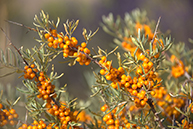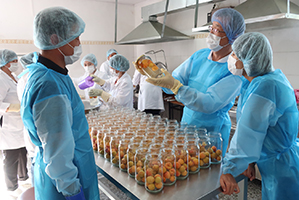Stories from the Field 1
Rebuilding the Regional Community through the “One Village One Product” Project
– Promoting the Successful Practice in Issyk-Kul Region across the Kyrgyz Republic and Supporting the Economic Independence of the People
In the Kyrgyz Republic, a former member of the Soviet Union, as a consequence of the collapse of the Union, economic activity slowed down and many people moved away to go abroad for work, which made regional communities dysfunctional and has worsened poverty. In order to rebuild these communities and encourage the economic independence of people in the Kyrgyz Republic, the One Village One Product (OVOP) project is being implemented across the country through the assistance by Japan.
The Issyk-Kul lake area in the northeast of the Kyrgyz Republic was selected as the first model site. This region produces many products which have high potential to be commercialized, such as salt, wool and wild fruits. However, there were many difficulties when the commercialization of products started in 2006.
“Since many people have lived a nomadic life, traveling with a family group, most of them were not used to working in a team with others. They had almost no experience to process agricultural products, so I taught them from the very beginning, such as how to use equipment and how to wash hands before work,” says Mr. Akihisa Haraguchi, a JICA expert who has worked in the field for many years, recalling the early days of the project. At first, it was even difficult to let the local people understand the importance of living an affluent life by making and selling products that are worth buying, not just making them.
Nevertheless, after two or three years, as people started to earn money by selling their products, their minds and behavior changed. They became more conscious of product quality, and capable of producing products based on certain standards.
A notable success story is about a project of felt products (stuffed toys woven from high-quality local wool), which was a joint project with Ryohin Keikaku Co., Ltd. (MUJI). The products were required to be made up to the same quality and design with other products sold around the world by MUJI. The producers’ technical skills and the level of quality control got improved significantly by catering to the requirements. Mr. Haraguchi reports that, “Currently each of around 500 individual producers residing separately in the Issyk-Kul lake area has got to be able to produce products satisfying required standards.”

Sea buckthorn growing wild in the Kyrgyz Republic, and being called as “miracle fruit” (Photo: JICA)
Furthermore, with its rich nature, the Kyrgyz Republic has numerous potential resources such as various types of plants. Among them, products made from natural sea buckthorn are expected to be developed in the near future. It contains polyphenols and various vitamins together with omega-3, 6, 7, and 9 fatty acids, which are expected to be beneficial for health. Thanks to this, sea buckthorn has recently drawn worldwide attention as a “superfood.” On the other hand, it was difficult to commercialize because it takes time to be harvested due to the thorns on its stalk. However, various products have currently been developed such as jams made with sea buckthorn flesh, and cosmetics made with its oil which is effective in preventing aging.

Local producers being instructed by a Japanese expert on food processing training (Photo: JICA)
The One Village One Product project in Issyk-Kul Region has grown significantly. Over the ten-years since the start of the project, the number of not only products but also people involved has increased from 500 to 2,300. Currently, projects have been expanded from the model site in Issyk-Kul to the whole region. Those products being produced and processed got to be highly evaluated as the “Issyk-Kul Brand,” and are sold at local shops as well as the OVOP Center in Bishkek. The prices are higher than other local products, yet local citizens also buy the products because of their high quality. Furthermore, foreign buyers also started to purchase the products. As such, the sea buckthorn jam is highly praised for its quality abroad and it won the gold prize at the World Food Expo held in Kazakhstan.
Since January 2017, further progress has been made to roll out the successful model in Issyk-Kul Region to other regions in the Kyrgyz Republic. Ms. Nargiza Erkinbayeva, the Chief Executive Officer (CEO) of the local public service corporation “OVOP+1” says as follows regarding her hopes for the future.
“Just as it was at the start in Issyk-Kul, the people in the Kyrgyz Republic rarely thought about processing agricultural products and resources into commercial products. In this regard, the fact that the project-participants now take the viewpoint of developing, producing and selling a product from the customer perspective is a significant achievement by Japanese experts’ support. In order to develop the project continuously, producers need to be economically independent and we will continue to provide support to this end. Over time, each region will become economically independent and able to develop the project on their own without our help. This is what I imagine for their future.”
Creating a structure to produce products competitive enough for the world market, first, in a single region, then spreading the project nationwide. Japan’s support is steadily advancing here in the Kyrgyz Republic toward this end.
Next Page >>
Main Text | Reference Statistics | Stories from the Field | Master Techniques from Japan to the World | ODA Topics
